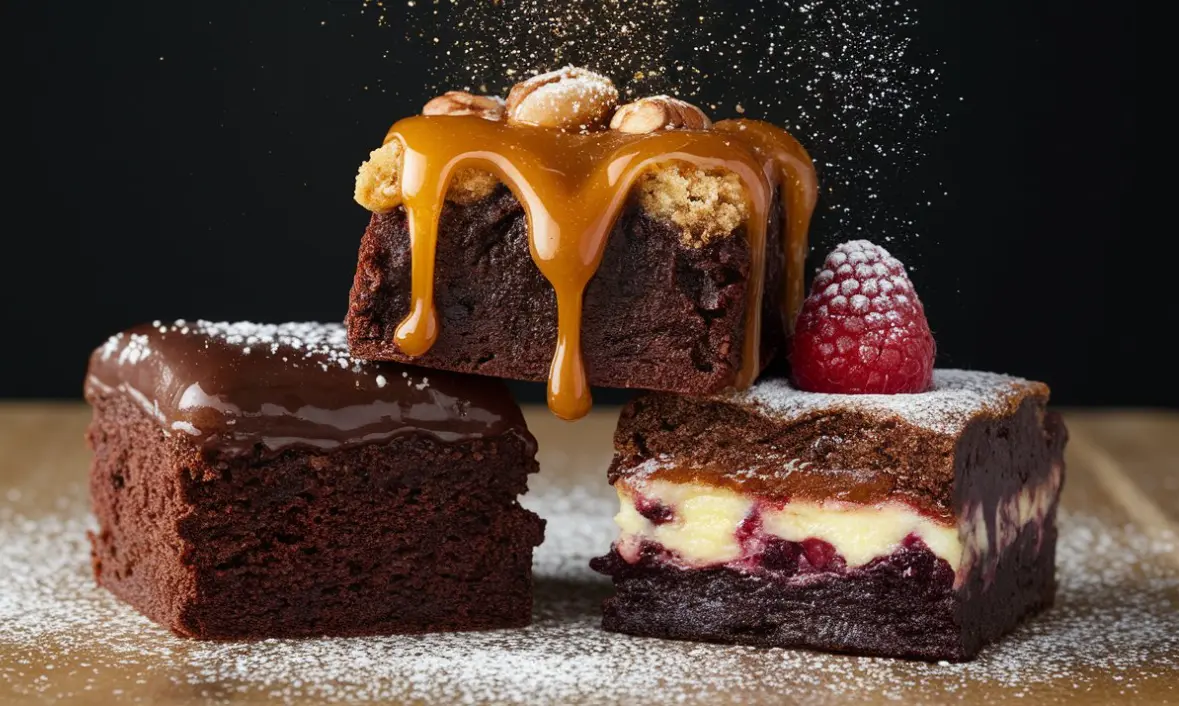Introduction to Brownies
Overview of Brownie Types
Ah, brownies! Is there anything better than settling down with a warm, chocolatey square of this classic dessert? Brownies come in a variety of textures that cater to every chocolate lover’s preference. In this section, we’re going to break down the three fundamental types of brownies: fudgy, cakey, and chewy. Each type has its fans, and understanding the differences can help you bake your perfect batch.
Fudgy Brownies: Rich, dense, and oh-so-chocolatey, fudgy brownies are the epitome of indulgence. They’re characterized by a high fat-to-flour ratio, which comes from generous amounts of butter and chocolate. This type is a hit for those who crave that intense, melt-in-your-mouth texture.
Cakey Brownies: If you fancy a lighter, fluffier treat, cakey brownies are the way to go. They’re made with a bit more flour and a leavening agent like baking powder, giving them a structure that’s similar to cake. Cakey brownies are perfect for folks who love a bit of airiness in their baked goods.
Chewy Brownies: Striking a delightful balance, chewy brownies are moist but not as dense as fudgy ones. They typically include an extra egg, which adds to their elasticity, providing a satisfying chewiness that isn’t too heavy or light.
By the end of this guide, you’ll not only be able to identify these types but also whip them up in your own kitchen! Let’s dive deeper into what makes each type special and how you can master the art of brownie-making. Stay tuned as we explore fudgy brownies next, detailing their characteristics and baking secrets that make them so irresistibly good.
Type 1: Fudgy Brownies
Characteristics of Fudgy Brownies
If heaven were a dessert, it would surely be a fudgy brownie. These delights are the quintessential treat for those who can’t get enough of that deep, rich chocolate flavor. Fudgy brownies are beloved for their dense, moist texture, which is achieved by a specific ratio of fat to flour and minimal use of leavening agents. They have a higher fat content, thanks to the liberal use of butter and chocolate, which makes them incredibly rich and almost melt-in-your-mouth.
Ingredients and Baking Techniques
Achieving the perfect fudgy brownie is an art form that any home baker can master with the right approach. Here’s how to get that gooey texture every time:
- Choose the Right Chocolate: The type of chocolate you use makes a massive difference. For the richest flavor, opt for high-quality semi-sweet or dark chocolate bars that you can chop up. These melt better and distribute more evenly than chips.
- Butter is Better: While some recipes call for oil, butter is the key to the fudgiest texture. It adds to the richness and provides a flavor depth that oil simply can’t match.
- Minimal Mixing: When combining your ingredients, mix just enough to blend them. Over-mixing can introduce air into the batter, leading to a cakey texture.
- Under-bake Slightly: The trick to that perfect fudgy middle is slightly under-baking your brownies. Take them out of the oven when the perimeter is firm, but the middle remains slightly tender. It will set as it cools, creating that signature gooey center.
- Cool Completely Before Cutting: Resist the temptation to cut into your brownies right away. Letting them cool completely allows the structure to set, which means cleaner cuts without crumbling.
Ready to give it a try? Grab your apron, preheat your oven, and let the magic happen as you bake up a batch of these delectable fudgy brownies. Next, we’ll explore the lighter, airier sibling in the brownie family: the cakey brownie. Stay tuned to learn how to make these fluffy delights that combine the best of both worlds—cake and brownie—in one delicious package!
Type 2: Cakey Brownies
What Makes Brownies Cakey?
Cakey brownies offer a delightful alternative for those who prefer their sweets with a bit more structure and fluffiness, akin to a classic cake. The texture of cakey brownies is lighter and more aerated, a result of different ingredient ratios and preparation methods compared to their fudgy counterparts.
These brownies tend to contain more flour and a leavening agent like baking powder, which helps them rise during baking. The addition of these elements gives cakey brownies their characteristic tender crumb and elevated structure.
Recipe Variations
Creating the perfect cakey brownie involves a few key adjustments to your standard brownie recipe, especially if you’re curious about “What are the three types of brownies” and want to explore the cakey variety. Here’s how you can ensure your brownies come out beautifully light and cake-like every time:
Increase the Flour: Adding a bit more flour to your batter than you would for fudgy brownies helps create the firmer texture that defines cakey brownies.
Add a Leavening Agent: A small amount of baking powder can make a big difference. This ingredient is crucial for helping the brownies rise and develop a cake-like structure.
Use More Eggs: Eggs are vital for providing structure and stability. For cakey brownies, consider adding an extra egg to your recipe to help the batter rise and stay light.
Creaming the Butter and Sugar: Unlike the melting method often used for fudgy brownies, creaming the butter and sugar together until light and fluffy incorporates air into the batter, promoting a lighter texture.
Bake Fully: Cakey brownies need to be fully baked to achieve their characteristic texture, so make sure to cook them until a toothpick inserted into the center comes out clean or with just a few crumbs attached.
With these tips in hand, you’re ready to bake a batch of cakey brownies that are sure to please anyone looking for a lighter, airier chocolate treat. Up next, we’ll dive into the chewy brownies—a favorite for those who love a good stretch with their bite!




